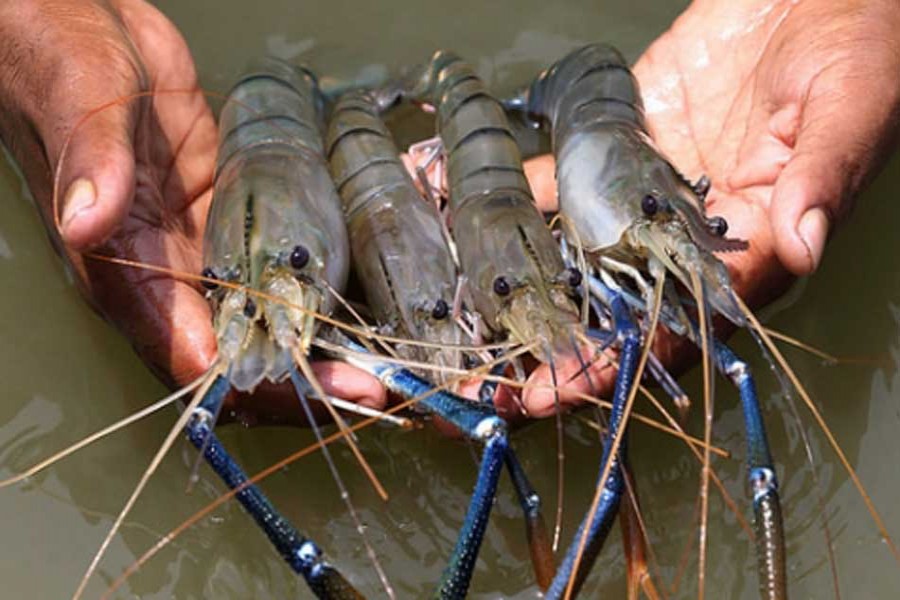With its export earning being heavily dependent on readymade garments (RMG) sector which contributes over 80 per cent to the total exports, diversification of Bangladesh's export basket has long been a major concern of the policymakers.
Here comes the issue of revamping the shrimp sector which has the potential to grow. But this vital sector has been facing serious troubles for long which should be addressed seriously to increase its contribution to the export basket.
Bangladesh, with annual export of $446 million, ranks 7th among the shrimp-exporting countries. The Export Promotion Bureau (EPB) says that in the July-December period of the current fiscal, export earning from shrimp was US$ 271.01 million against the $ 265.93 million of the previous fiscal.
Right now the country is apparently missing a golden opportunity to boost the shrimp sector. In the global market, prices of the black tiger shrimps are rising. According to reports, the price of one pound of tiger shrimp has jumped from US$ 4.5 to US$ 7.0 by one year but Bangladesh cannot exploit this opportunity due to shortfall in the production.
With roughly 40,000 tons of annual exports now, the country's market share is 2.0 per cent. Proper policy support and enabling environment can jack up the share by four times, experts estimate.
One of the major problems in this regard is low yield. The country grows shrimp on 275 thousand hectares in the saline-prone south-western coastal region and over 0.8 million farmers are engaged in producing briny water shrimp and prawn.
But harvest rate, which is 450 kilograms per hectare, is lower than other major exporting countries.
To enhance both production and yield some measures are necessary which include increasing the efficiency in the supply chain. This can be done through strengthening the bargaining position of farmers with middlemen and exporters.
Improving the infrastructure in the supply chain, including cold storage facilities, proper ice factories and transport, and training middlemen and traders are required.
Two key requirements to increase productivity are giving training to farmers in Best Aquaculture Practices (BAP) and improving quality of inputs.
Enhancing the yield has been a critical factor for the stakeholders for long. Traditional system of shrimp farming has undergone to a number of evolutions in the recent past.
In the 80s, shrimp farming in the country got boost owing to its export potential. Shrimp culture became popular due to its high value in the world market as well as its unique taste. Shrimp fry, trapped in salt beds, coastal paddy fields or brackish water fishponds, are now allowed to grow to marketable size and harvested as secondary crop. However, in recent years when higher income are derived from the harvest of shrimp than the principal crop, many farmers have converted their rice fields, salt beds and fishponds into shrimp farms.
In the traditional system, fry, either collected from the wild or concentrated through tidal water, are being stocked in the ponds.This method provides low yield because of inefficient control of predators and competitors, full dependence on natural food, inadequate pond depth and water quality management.
some improvements of the traditional farming systems have been made in the past years as stocking density of shrimp is increased through better management practices. This has resulted in increased yield.
According to experts, expansion of the shrimp farming industry in the country is still restricted due to the lack of suitable culture technology and disease problems. They think that "mass production of shrimp can be achieved to 4-5 tons per hectare through improved pond culture techniques, water quality management and artificial feeding."
Optimisation of stocking density in shrimp farming is crucial for maximising the survival rate and also for boosting production. Stocking density is also related to the culture system and agro-ecological conditions.
With the improvement of culture technology, management system and higher market price of shrimp, it is needed to increase production from the limited resources.
Focus should also be given on increasing the share of value-added products in the export basket, improving the image of Bangladeshi shrimp abroad and on investing in food safety and sustainable certification initiatives. Investment in certification schemes such as the Aquaculture Certification Council is also termed as a strategy to increase the value of shrimp products.
The sector needs skilled workers in processing establishments. The local workers can be trained up by hiring Indian and Thai workers.
Shrimp exporters get subsidies but the sector as a whole should get low-cost loan facilities.
The government can take initiative to improve the shrimp cultivation land like it is doing for the export processing zones. Shrimp farming is mostly concentrated in the southern region with Khulna, accounting for 145 thousand hectares of land, having about 80 per cent share of the total cultivation area.
While production of shrimp in major exporting countries like China, Vietnam and Thailand is going down, its demand is going up. This is the opportune moment for the stakeholders of the shrimp sector to pull their shocks up to raise their share in the global market.


